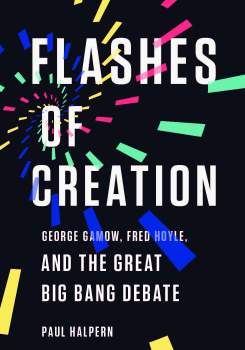The Debate That Sparked The Big Bang
How a 1940s horror movie inspired maverick physicist Fred Hoyle’s now-panned alternative to the Big Bang.
The following is an excerpt from Flashes of Creation: George Gamow, Fred Hoyle, and the Great Big Bang Debate by Paul Halpern.
Disclaimer: When you purchase products through the Bookshop.org link on this page, Science Friday may earn a small commission which helps support our journalism.

Flashes of Creation: George Gamow, Fred Hoyle, and the Great Big Bang Debate
From the mid-1930s until the mid-1940s, few physicists published in the field of cosmology. The burst of energy that had centered on the idea of a dynamic universe had almost completely dampened out. Many researchers considered the work of Howard P. Robertson, at the start of that fallow decade, which had delineated all the possibilities for homogeneous, isotropic universes, the final word on the subject. Perhaps it would have been if it weren’t for a splendid insight about an eternal universe that curiously emerged from a discussion about a horror film.
Hoyle, Bondi, and Gold had become close friends during the war and remained so afterward. Starting in autumn 1945, Hoyle, beginning his long-delayed fellowship at St. John’s College, and Bondi, a fellow at Trinity College teaching mathematics, often got together in Cambridge, with Gold sometimes joining them. Gold had continued with naval research until being appointed to a position at Cavendish in 1947.
One evening, likely in 1946 or early 1947, the three of them decided to take a break from their heady discussions of astronomy and head over to a Cambridge cinema. Hoyle’s love for the movies had persisted since childhood, when his mother’s job was playing piano in the cinema to help dramatize the scenes of silent films. Deciphering the complex plots of thrillers and murder mysteries—staples of British filmmaking—was part of the attraction for him. As with his beloved game of chess, Hoyle tried to anticipate the moves. That pursuit also matched his attitude toward science—deciphering the world as a kind of self-driven detective, following leads that might have eluded others.
The three scientists settled down to watch a horror film, The Dead of Night. The movie has an unusual plot twist that connects its beginning and ending in a seemingly endless cycle. The machinations of the convoluted tale of terror made an indelible imprint on their imaginations.
Invest in quality science journalism by making a donation to Science Friday.
The story begins with an architect, Walter Craig, arriving at a country house to which he has been invited by its owner, Eliot Foley, as a guest at a gathering but also to offer advice on design. Although ostensibly it is a gathering of strangers Craig had never met before in his life, he reveals that they all seem familiar because he has dreamed repeatedly and vividly of meeting them in that very setting. After he tells the dubious fellow guests of his foreboding that something bad will happen, they share their own nightmarish visions in a series of terrifying sequences that make up much of the film. The scariest (and most famous) of these is a ventriloquist tormented by his evil dummy, Hugo. As the horrific tales reach a crescendo, Craig—as if possessed by a demon—suddenly becomes overwhelmed by an irresistible urge to commit murder. In a wholly unexpected plot twist, he gruesomely kills one of the guests (for no apparent reason), is arrested by a police officer, and ends up in a prison cell, with a grinning Hugo mocking him and beginning to strangle him.
Suddenly Craig wakes up. It was all a nightmare. He is terrified but doesn’t remember precisely why. The phone rings, and it is Foley, who invites him to visit his home (which Craig thinks would be for the first time). At that point, for some reason, Craig momentarily doesn’t realize that the country house is connected with his bad dream. With a rural excursion seeming like a relaxing escape, Craig gets in his car, drives over there, and all of the events recur—implying that they’ll continue to do so forever.
Hoyle, Bondi, and Gold left the cinema and returned to Bondi’s rooms at Trinity. Bondi offered the others some rum he had procured from a relative. Upon discussing the film while downing their drinks, Gold suddenly remarked, “What if the Universe is like that?”
Gold’s comment inspired lengthy discussions about imagining an expanding universe that appears roughly the same over time, with no beginning and no ending. Like someone entering a movie theater in which The Dead of Night was looped over and over again to begin watching it at any random part, those viewing a “film” of the universe could start at any moment and see a similar picture. The main issue that emerged was how to fill in the gaps in the forever-growing empty spaces between expanding galaxies. The three began to think about how exactly new material could trickle into the universe and create new formations in the voids left behind by the receding galaxies. Amazingly, in a quintessential example of how gut feelings can drive science for intuitive thinkers such as Hoyle, a cinematic vision of terror led to a whole new model of the cosmos.
Excerpted from Flashes of Creation: George Gamow, Fred Hoyle, and the Great Big Bang Debate by Paul Halpern. Copyright 2021. Available from Basic Books, an imprint of Hachette Book Group, Inc.
Paul Halpern is a professor of physics at the University of the Sciences in Philadelphia. His most recent book is “Flashes of Creation: George Gamow, Fred Hoyle, and the Great Big Bang Debate.”